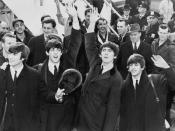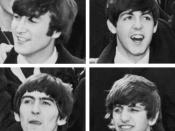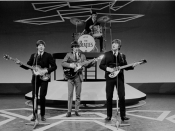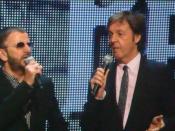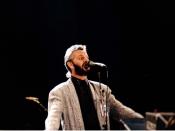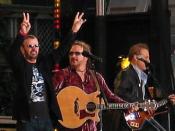On July 7th, 1940, in a poor and rough working-class section of Liverpool known as "the Dingle,"ÃÂ Richard Starkey Jr. (a.k.a. Ringo Starr) was born to his proud parents, Richard Starkey Sr. and Elsie Gleave. Ringo would later go on to become the drummer for world-renowned British rock band, the Beatles, as their drummer, a job that most certainly fit him well. He turned out to be an excellent drummer for the group, never overshadowing the music, working along with the song and the singer, and feeding the others with his steady backbeat. The rest of the group recognized these talents, and depended on him because of them. "Playing without Ringo is like driving a car on three wheels,"ÃÂ states George Harrison, guitarist for the Beatles. He was a both happy and sensitive individual with a natural wit, wry humor, and an easy-going nature that would draw people to him and earn him the title of "the lovable Beatle."ÃÂ
"Ringo's just a lad,"ÃÂ says fellow Beatle, Paul McCartney, "everybody always loved him,"ÃÂ (Shultz, Gary. "Ringo Starr Biography, From Birth Through the Beatles,"ÃÂ the Ringo Starr WWW Site at http://web2.airmail.net/gshultz/, 1997, p. 1-4.).
Ringo, then called Richie, had a very hard early life. At the age of three, his father left home, leaving his mother Elsie to care for him alone. To support the two of them, she went to work as a barmaid, leaving Richie in the care of the neighbors or his grandparents. In 1944, they had to leave their six-room terrace house, and move to a smaller, cheaper terrace home around the corner (Shultz, p.1.).
When he was five, little Richie started school at St. Silas Infant's School, but when he was six he developed appendicitis, and his appendix later ruptured which resulted in peritonitis (inflammation of the membrane that lines the cavity of the abdomen) and a ten-week coma. His mother, Elsie, was frequently told that he might not live, but he eventually began to recover after about six months in the hospital. On his seventh birthday, with discharge in sight, his grandfather dropped by to give him a birthday present"ÃÂa bright red bus. "I thought it would be nice to give him my red bus to cheer him up,"ÃÂ says his grandfather. Richie was so excited that he immediately began driving it around his bed. After his grandfather left, Richie looked over and, "the boy in the next bed looked so sad and lonely, I thought it would be nice to give him my red bus to cheer him up,"ÃÂ says Starr. As he leaned over to give it to him, he fell from his bed, and when he awoke he discovered that he had burst stitches and now had to stay in the hospital for six more months. When he was finally released, he was far behind in his schoolwork and couldn't read or write, and despite tutoring, he couldn't pass the tests he needed to move on to the grade he belonged in, so he had to stay back with the younger children (Shultz, p.1. Clayson, Alan. Ringo Starr, Straight Man or Joker? 1991, p.6.).
In 1953, with his enthusiastic blessing, Richie's mother, remarried Harry Graves, but later that year Richie developed pleurisy (inflammation of membrane that lines each half of thorax which results in cough, fever, and pain and difficulty in breathing). This time he was hospitalized for two years with virtually no schooling. When he was finally released, at the age of fifteen, still quiet, thoughtful, and as easy-going as he had been throughout his childhood, he realized that returning to school to pursue his education was impossible since he had missed so much work. He then began looking for a job. His first job was as a messenger for the British Railroad, but he had to quit when he failed the medical exam. Next he worked as a barman on a boat traveling between Liverpool and Wales, but was fired for showing up drunk and then lipping off to his boss. Finally, at the age of seventeen, he found a steady job with Henry Hunt and Son's Engineering Firm as an apprentice (Shultz, p.2.).
Around this same time, the skiffle music craze hit and Richie entered into the music scene. He started a skiffle band with a fellow apprentice named Eddie Miles, called the Eddie Clayton Skiffle Group. Richie played percussion, and with the help of some other musically talented employees, they would entertain the workers at lunch time, and would play at parties and local competitions. In 1957, while out at a business outing, Harry Graves bought his stepson his first set of drums, second-hand, for about 10 pounds. He lugged them onto a train and had to sit with them on the ride home. Richie attacked the new kit with gusto, showing no signs of ever stopping. He eventually developed great hand-and-foot coordination, accurate time keeping, and even began developing his own unique style. Because of the noise, his mother eventually limited his playing time to only thirty minutes per evening. "I got really bored, just sitting there banging because you can't play any tunes,"ÃÂ Ringo states. After he would finish his thirty minutes of playing, his mother also objected to him banging around on the furniture to the beat of radio. "And that was it for me, practicing. Drumming's simple. I've always believed the drummer is not there to interrupt the song,"ÃÂ he explains (Shultz, p.2. Clayson, p.20-21.).
Richie later replaced his first set with a black Premier kit which made him the ideal drummer for any band in the area. He eventually joined the Darktown Skiffle Group, but often sat in for many other bands. In November 1959, he officially joined Rory Storm and the Hurricanes, and by 1960 they were Liverpool's top-ranked band. They were offered a thirteen weeks summer job in Wales, but this brought on difficulties for Richie, who's name had been changed with the help of Rory, the leader of his band. Because of his passion for wearing so many rings, the name "Rings"ÃÂ was given to him, which was later changed to the more western-sounding "Ringo."ÃÂ His last name, Starkey, was shortened to Starr because it fit his act, which could now be called "Starr Time."ÃÂ Ringo was faced with the decision of whether or not to follow the band to Wales, because if he did he would have to give up his apprenticeship at Hunt and Sons, and would have to leave his fiancee, Geraldine. The excellent pay and lures of adventure were too much to resist, and off went Ringo, calling off the engagement, and throwing away his day job for a summer of fun and music (Shultz, p.3.).
By Autumn of that same year, Rory and the Hurricanes were playing at the top of the bill in Hamburg, Germany, where Ringo met another Liverpool band, the Beatles. They had been hired to play at a lesser-known club, but had been transferred at the last minute. The two groups got along well, and Ringo became well acquainted with the Beatles, especially George Harrison. He often hung around and listened to them on his breaks, and even sat in for their drummer, Pete Best, a few times. By 1961, Ringo was becoming tired with the Hurricanes whose career appeared to be slowing, and tried to immigrate for a factory job in Texas, but the paperwork put him off. In 1962, Ringo returned to Hamburg, but despite great luxuries offered to him in a job playing drums for Tony Sheridan, Ringo returned to the Hurricanes for their third summer session. Later that year he was given two job offers, one of which was from the Beatles. Ringo eagerly joined them, and first played with them on August 18, 1962, just eighteen days before their first scheduled recording session for EMI at Abbey Road Studios (Shultz, p.3.).
To Ringo's dismay, he wasn't allowed to play drums at the first session. Instead he was handed maracas and a tambourine because their producer, George Martin, didn't trust his playing, so they had a studio musician sit in. However, Ringo was later able to prove himself, and eventually his version of "Love Me Do"ÃÂ was the one released on the single. George Martin never again doubted Ringo's drumming abilities. For a while, Ringo didn't feel like he really fit in with the group, but his wonderful personality shone through for him and soon he felt right at home with the band. Although many people objected to the Beatles firing Pete Best for Ringo Starr, they now believe it was one of the smartest things they could have done. In response to a question about whether or not it was a good idea for them to replace Pete Best, John B. [my dad], a long-time Beatle fan, responds by saying, "Pete Best did not have the drumming skills necessary for a great group. That was recognized by the other Beatles and they had to find a new drummer to improve the band. Ringo was the most talented drummer in the Liverpool area at the time, had filled in as drummer for the Beatles on numerous occasions, and his drumming meshed well with the rest of the band,"ÃÂ (Shultz, p.3-4. B., John. Feb. 25, 1998.).
The Beatles' music then began climbing the charts and they were off! The shows, the touring, and everything else came next. They earned themselves world-wide acclaim as one of history's greatest bands. Through it all Ringo served them well. When asked why he was always the favorite Beatle in America, Ringo humbly replies, "I'm not so sure that I was. The fans seemed to get more involved with the other three."ÃÂ Besides being a great drummer for the band, he was always on good terms with the three others, which helped resolve problems within the group. "But, what I think was his most important contribution, was as a steadying influence within the band who could bridge gaps between John Lennon and Paul McCartney. His good humor, and self-depreciating style, I feel, helped cut the tension within the band, and made for more harmony between the members. Everyone in the band liked Ringo, even when they seemed mad at each other, they didn't seem mad at Ringo. Ringo used that to help create good will in the band. His humor helped to break tensions that erupted in the band, especially in the later days of the Beatles,"ÃÂ states John B. Ringo seemed to enjoy being in the group, even when it got hard on all of the hectic tours. "We get on together because there are only four people in the world like us. When there was all that Beatlemania we were pushed into a corner, just the four of us. A sort of trap really, like Siamese quads eating out of the same bowl,"ÃÂ explains Ringo. As you can see, even though Ringo didn't contribute as many musical pieces to the group, he still had many powerful impacts on it, and played a very large role in the group's existence (Shultz, p.4. John B., Feb. 25, 1998. Klemesrud, Judy. "But His Teeth Are Regular Pearls."ÃÂ The New York Times. June 1, 1969, part II, p.11. Cleave, Maureen. "Old Beatles "ÃÂ A Study in Paradox."ÃÂ The New York Times Magazine. July 3, 1966, p.10-11.).
On February 11, 1965, Ringo married his girlfriend, Mary (Maureen) Cox, a match stick blond with kohl-rimmed eyes, whom he first met at the Cavern Club in Liverpool, where the Beatles got their start. After they started dating, Maureen began receiving hate letters and threatening phone calls from jealous fans, and a couple of girls even went as far as to vow to stab her, and one scratched her on the face while she was waiting for Ringo in a car. She had been a student hairdresser in Liverpool, and was eighteen, and pregnant when they got married. On September 13 of that same year, Zak Starkey was born. Because Ringo had always longed for siblings himself, he wanted the same for little Zak, and on August 19, 1967, Jason Starkey was born (Shultz, p.4. Klemesrud, part II, p.11.).
Sadly, the Beatles officially broke up in December, 1970, but Ringo was the only one who stayed on good terms with the other three. By this time, Ringo already had two solo albums, Beaucoups of Blues, and Sentimental Journey. Besides releasing more albums and singles, Ringo also played on solo albums done by the other Beatles, and played in several movies. On November 11, 1970, Lee Parkin Starkey was born, but sadly Ringo and Maureen, who seemed such a perfect match, were shockingly divorced in July, 1975. Ringo would go on to open and then later close Ring O Records, and continued to make appearances in movies and on television in series, such as Thomas the Tank Engine. Unfortunately, his health took a severe turn for the worse in 1979, and he had to have several feet of intestine removed (Shultz, p.4. Shultz, Gary. Ringo Starr Biography, From the Breakup to the Return of Bruno, p.3.).
In February of 1980, while filming Caveman, Ringo fell in love with co-star, Barbara Bach, an American model and actress best-known for her part in the James Bond movie The Spy Who Loved Me. They survived a serious car crash in England on May 19 of that same year. They were married on April 27, 1981 (Shultz, From the Breakup to The Return of Bruno, p.3.).
All-in-all, I feel that Ringo Starr played a very large role in the music of the Beatles as their drummer, and in putting together his all-star tours. He most certainly achieved his goal that he made when he was 3ÃÂý , to end up "sort of unforgettable,"à(John B., Feb. 25, 1998. Cleave, p.31.).
Bibliography B., John, my Dad, a long-time Beatle fan who knows a good deal about the group. February 25, 1998.
Clayson, Alan. Ringo Starr: Straight Man or Joker? Paragon House Publishers, New York, New York, 1991.
Cleave, Maureen. "Old Beatles "ÃÂ A Study in Paradox."ÃÂ New York Times Magazine. New York, New York, July 3, 1966, p.10-11, 30-32.
Klemesrud, Judy. "But His Teeth Are Regular Pearls."ÃÂ The New York Times. New York, New York, June 1, 1969, part II, p.11.
Shultz, Gary. "Ringo Starr Biography, From Birth to the Beatles, and From the Breakup to the Return of Bruno. The Ringo Starr WWW Site at http://web2.airmail.net/gshultz/, 1997, p.1-4, 1-5.
